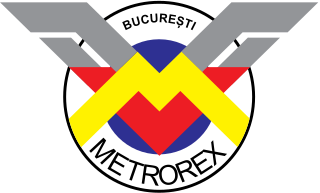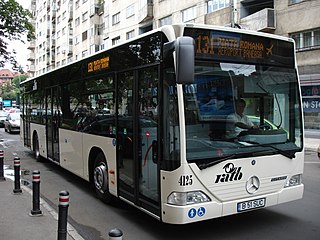
The Bucharest Metro is an underground rapid transit system that serves Bucharest, the capital of Romania. It first opened for service on 16 November 1979. The network is run by Metrorex. One of two parts of the larger Bucharest public transport network, Metrorex had an annual ridership of 142,783,000 passengers during 2023, compared to over a billion annual passengers on Bucharest's STB transit system. In total, the Metrorex system is 80.1 kilometres (49.8 mi) long and has 64 stations.

Bucharest has the largest transport network in Romania, and one of the largest in Europe. The Bucharest transport network is made up of a metro network and a surface transport network. Although there are multiple connection points, the two systems operate independently of each other, and are run by different organisations (the metro is run by Metrorex and the surface transport network by Bucharest-Ilfov Intercommunity Development Association for Public Transport. The two companies used separate ticketing systems until 2021, when a new smartcard was introduced alongside the old tickets, which allows travel on both the TPBI and the Underground.

Societatea de Transport București is the main public transit operator in Bucharest, Romania, owned by the Municipality of Bucharest. From 1990 to 2018, the company had a different legal status and was known as the Regia Autonomă de Transport București (RATB).

The Blackpool Tramway runs from Blackpool to Fleetwood on The Fylde in Lancashire, England. The line dates back to 1885 and is one of the oldest electric tramways in the world. It is operated by Blackpool Transport Services (BTS) and runs for 18 km. It carried 4.7 million passengers in 2023/24.

A buffer stop, bumper, bumping post, bumper block or stopblock (US), is a device to prevent railway vehicles from going past the end of a physical section of track.

Militari is a district in the western part of Bucharest, in Sector 6. It is home to more than 100,000 inhabitants.

Drumul Taberei is a neighbourhood located in the south-west of Bucharest, Romania, roughly between Timișoara Avenue and Ghencea Avenue, neighboring Militari to the north, Panduri to the east and Ghencea, and Rahova to the south and south-east.

The Harrow and Wealdstone rail crash was a three-train collision at Harrow and Wealdstone station in Wealdstone, Middlesex during the morning rush hour of 8 October 1952. The crash resulted in 112 deaths and 340 injuries, 88 of these being detained in hospital. It remains the worst peacetime rail crash in British history and the second deadliest overall after the Quintinshill rail disaster of 1915.

T4 is a tram produced by ČKD Tatra. It is the narrower variant of the Tatra T3 model. A large number of cars was supplied to the GDR, the USSR, Romania and the former Yugoslavia using names T4D, T4SU, T4R and T4YU, respectively. The T4 was originally developed in 1968 and has been continuously modernized or copied since.

A bi-articulated bus or double-articulated bus and sometimes train-bus, tram-bus, trackless tram or double bendy bus is a type of high-capacity articulated bus with an extra axle and a second articulation joint, as well as extended length. Bi-articulated buses tend to be employed in high-frequency core routes or bus rapid transit schemes rather than in conventional bus routes.

The Trieste–Opicina tramway is an unusual hybrid tramway and funicular railway in the city of Trieste, Italy. It links Piazza Oberdan, on the northern edge of the city centre, with the village of Villa Opicina in the hills above.

The Bucharest light rail is a light rail transit system in Bucharest, Romania.

Ghencea is a district of the Romanian capital city Bucharest, split between Sector 5 and Sector 6. It is home to the famous sports club CSA Steaua București. Nearby districts are Drumul Taberei and Rahova.

The Bombardier CR4000 is a 76% low floor model of the Bombardier Flexity Swift series of tram operated by Tramlink in London. They are based on and very similar in appearance to the K4000 used on the low-platform routes of the Cologne Stadtbahn network. Built between 1998 and 2000, the trams entered service in the spring of 2000.

On 9 November 2016, a tram operated by Tramlink in London derailed and overturned on a sharp bend approaching a junction. Of 69 passengers, there were seven fatalities and 62 injured, 19 of whom sustained serious injuries. This was the first tram incident in the United Kingdom in which passengers died since 1959.

Timiș 2 were a series of tram vehicles built in Timișoara, Romania, initially by the Timișoara Transport Company, and later by Electrometal Timișoara.

The Bucharest Articulated Tramcar series is a series of tram vehicles produced between 1971 and 1992 by URAC, the main workshops of the Bucharest Transit Company. Various modernized variants have also been delivered since 1993. For the last 50 years they have been the backbone of the tram network in Bucharest, replacing motor-trailer formations that had run in the city since the introduction of electric trams.


















